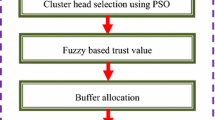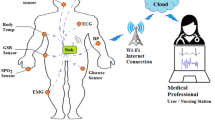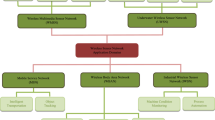Abstract
The wireless body sensor network (WBSN) an extensive of WSN is in charge for the detection of patient’s health concerned data. This monitored health data are essential to be routed to the sink (base station) in an effective way by approaching the routing technique. Routing of tremendous sensed data to the base station minimizes the life time of the network due to heavy traffic occurrence. The major concern of this work is to increase the lifespan of the network which is considered as a serious problem in the wireless network functionalities. In order to recover this issue, we propose an optimal trust aware cluster based routing technique in WBSN. The human body enforced for the detection of health status is assembled with sensor nodes. In this paper, three novel schemes namely, improved evolutionary particle swarm optimization (IEPSO), fuzzy based trust inference model, and self-adaptive greedy buffer allocation and scheduling algorithm (SGBAS) are proposed for the secured transmission of data. The sensor nodes are gathered to form a cluster and from the cluster, it is necessary to select the cluster head (CH) for the effective transmission of data to nearby nodes without accumulation. The CH is chosen by considering IEPSO algorithm. For securable routing, we exhibit fuzzy based trust inference model to select the trusted path. Finally, to reduce traffic occurrence in the network, we introduce SGBAS algorithm. Experimental results demonstrate that our proposed method attains better results when compared with conventional clustering protocols and in terms of some distinctive QoS determinant parameters.








Similar content being viewed by others
References
Kulkarni, R. V., et al. (2011). Particle swarm optimization in wireless-sensor networks: A brief survey. IEEE Transactions on Systems, Man, and Cybernetics, 41(2), 262–267.
Bradai, N., Fourati, L. C., & Kamoun, L. (2015). WBAN data scheduling and aggregation under WBAN/WLAN healthcare network. Ad Hoc Networks, 25, 251–262.
Al-Janabi, S., Al-Shourbaji, I., Shojafar, M., & Shamshirband, S. (2017). Survey of main challenges (security and privacy) in wireless body area networks for healthcare applications. Egyptian Informatics Journal, 18(2), 113–122.
Heinzelman, W., Chandrakasan, A., & Balakrishnan, H. (2000). Energy-efficient communication protocol for wireless micro sensor networks. In Proceedings of the 33rd annual Hawaii international conference on system sciences (Vol. 2).
He, Y., Zhu, W., & Guan, L. (2011). Optimal resource allocation for pervasive health monitoring systems with body sensor networks. IEEE Transactions on Mobile Computing, 10(11), 1558–1575.
Thotahewa, K., Khan, J., & Yuce, M. (2014). Power efficient ultra wide band based wireless body area networks with narrowband feedback path. IEEE Transactions on Mobile Computing, 13(8), 1829–1842.
Sharma, S., & Jena, S. (2015). Cluster based multipath routing protocol for wireless sensor networks. ACM SIGCOMM Computer Communication Review, 45(2), 14–20.
Sundararaj, V. (2016). An efficient threshold prediction scheme for wavelet based ECG signal noise reduction using variable step size firefly algorithm. International Journal of Intelligent Engineering System, 9(3), 117–126.
Arboleda, L. M., & Nasser, N. (2006). Comparison of clustering algorithms and protocols for wireless sensor networks. In IEEE conference on electrical and computer engineering (pp. 1787–92).
Tyagi, S., Gupta, S., Tanwar, S., & Kumar, N. (2013). Ehe-leach: Enhanced heterogeneous leach protocol for life time enhancement of wireless SNs. In 2013 international conference on advances in computing, communications and informatics (ICACCI) (pp. 1485–1490).
Kumar, D. (2014). Performance analysis of energy efficient clustering protocols for maximizing lifetime of wireless sensor networks. IET Wireless Sensor Systems, 4, 9–16.
Bader, A., Abed-Meraim, K., & Alouini, M. (2012). An efficient multi-carrier position-based packet forwarding protocol for wireless sensor networks. IEEE Transactions on Wireless Communications, 11(1), 305–315.
Zhang, Y., Huang, D., Ji, M., & Xie, F. (2013). The evolution game analysis of clustering for asymmetrical multi-factors in WSNs. Computers & Electrical Engineering, 39(6), 1746–1757.
Jin, R., Gao, T., Song, J., Zou, J., & Wang, L. (2013). Passive cluster-based multipath routing protocol for wireless sensor networks. Wireless Networks, 19(8), 1851–1866.
Du, T., Qu, S., Liu, F., & Wang, Q. (2015). An energy efficiency semi-static routing algorithm for WSNs based on HAC clustering method. Information Fusion, 21, 18–29.
Mahajan, S., Malhotra, J., & Sharma, S. (2014). An energy balanced QoS based cluster head selection strategy for WSN. Egyptian Informatics Journal, 15(3), 189–199.
Wu, D., Bao, L., & Liu, C. H. (2013). Scalable channel allocation and access scheduling for wireless internet-of-things. IEEE Sensors Journal, 13(10), 3596–3604.
Wu, D., Bao, L., Regan, A. C., & Talcott, C. L. (2013). Large-scale access scheduling in wireless mesh networks using social centrality. Journal of Parallel and Distributed Computing, 73(8), 1049–1065.
Rezaee, A. A., & Pasandideh, F. (2018). A fuzzy congestion control protocol based on active queue management in wireless sensor networks with medical applications. Wireless Personal Communications, 98(1), 815–842.
Jiang, C., Shi, W., Xiang, M., & Tang, X. (2010). Energy-balanced unequal clustering protocol for wireless sensor networks. The Journal of China Universities of Posts and Telecommunications, 17(4), 94–99.
Latiff, N., Tsimenidis, C., & Sharif, B. (2007). Energy-aware clustering for wireless sensor networks using particle swarm optimization. In IEEE 18th international conference on personal, indoor and mobile radio communications (PIMR C’07) (pp. 1–5).
Ren, J., Zhang, Y., Zhang, K., & Shen, X. (2016). Adaptive and channel-aware detection of selective forwarding attacks in wireless sensor networks. IEEE Transactions on Wireless Communications, 15(5), 3718–3731.
Abdul Latiff, N., Tsimenidis, C., & Sharif, B. (2007). Performance comparison of optimization algorithms for clustering in wireless sensor networks. In IEEE international conference on mobile adhoc and sensor systems (pp. 1–4).
Rahmanian, A., Omranpour, H., Akbari, M., & Raahemifar, K. (2011). A novel genetic algorithm in leach-c routing protocol for sensor networks. In 24th Canadian conference on electrical and computer engineering (CCECE) (pp. 001096–001100).
Hacioglu, G., Kand, V., & Sesli, E. (2016). Multi objective clustering for wireless sensor networks. Expert Systems with Applications, 59, 86–100.
Khalil, E. A., & Attea, B. A. (2011). Energy-aware evolutionary routing protocol for dynamic clustering of wireless sensor networks. Swarm and Evolutionary Computation, 1(4), 195–203.
Djenouri, D., & Balasingham, I. (2009). New QoS and geographical routing in wireless biomedical sensor networks. In 6th international conference on broadband communications, networks, and systems (pp. 1–8).
Heinzelman, W., Chandrakasan, A., & Balakrishnan, H. (2002). An application-specific protocol architecture for wireless micro sensor networks. IEEE Transactions on Wireless Communications, 1, 660–670.
Author information
Authors and Affiliations
Corresponding author
Rights and permissions
About this article
Cite this article
Isabel, R.A., Baburaj, E. An Optimal Trust Aware Cluster Based Routing Protocol Using Fuzzy Based Trust Inference Model and Improved Evolutionary Particle Swarm Optimization in WBANs. Wireless Pers Commun 101, 201–222 (2018). https://doi.org/10.1007/s11277-018-5683-8
Published:
Issue Date:
DOI: https://doi.org/10.1007/s11277-018-5683-8




